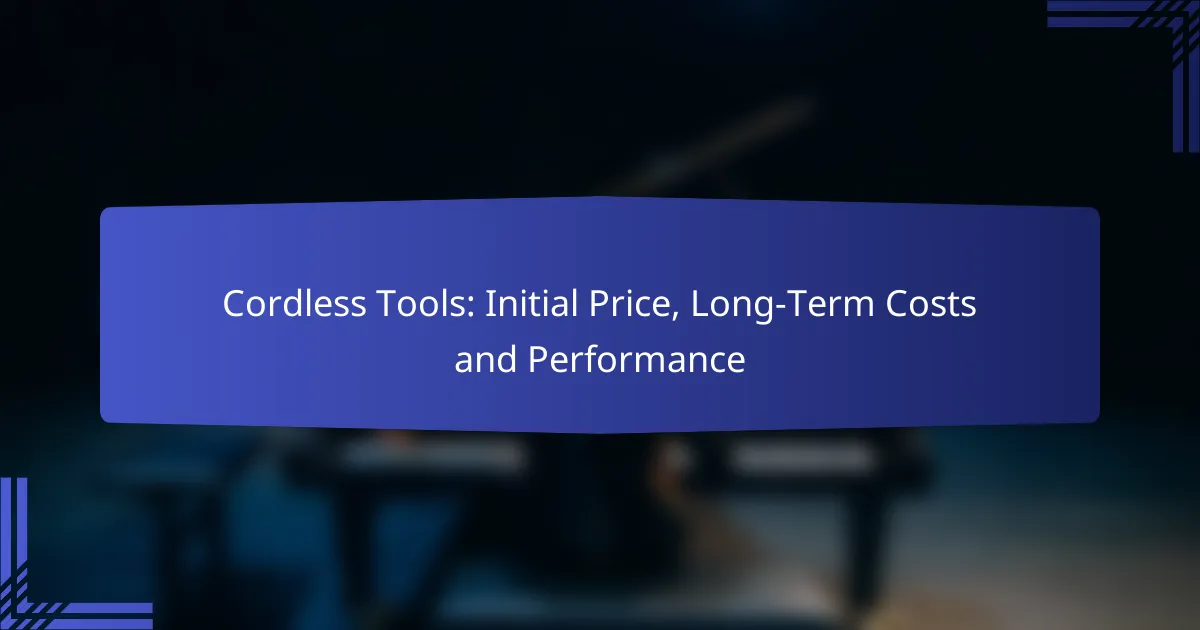When considering cordless tools, it’s essential to evaluate their initial prices, which can range from affordable entry-level options to premium models from well-known brands. Additionally, long-term costs, including battery replacements and maintenance, play a crucial role in overall ownership expenses. Performance also varies significantly among these tools, influenced by factors like battery life, torque, and speed, making it vital for users to choose the right tool for their specific needs.

What are the initial prices of cordless tools?
The initial prices of cordless tools vary significantly based on brand, features, and intended use. Entry-level options can be quite affordable, while high-end models from reputable brands come at a premium.
Entry-level models start around $50
Entry-level cordless tools typically start at around $50, making them accessible for casual users or DIY enthusiasts. These models often include basic features and are suitable for light tasks such as home repairs or small projects.
When considering entry-level tools, look for essential features like battery life and charging time. While they may lack advanced capabilities, they can still provide reliable performance for everyday tasks.
Premium brands like DeWalt and Milwaukee range from $150 to $300
Premium cordless tools from brands like DeWalt and Milwaukee generally range from $150 to $300. These tools are designed for professionals and serious hobbyists, offering superior performance, durability, and advanced features.
Investing in a premium model often means better battery technology, longer run times, and enhanced ergonomics. If you frequently tackle demanding projects, the higher initial cost can be justified by the tool’s longevity and efficiency.

What are the long-term costs of owning cordless tools?
The long-term costs of owning cordless tools primarily include battery replacements and maintenance expenses. Understanding these costs can help you budget effectively and ensure the tools remain functional over time.
Battery replacements can cost $30 to $100
Battery replacements are a significant long-term expense for cordless tool owners. Depending on the brand and capacity, replacement batteries typically range from $30 to $100 each. It’s essential to consider the frequency of battery replacements based on usage; heavy users may need to replace batteries more often.
When purchasing a cordless tool, check the battery warranty and lifespan. Some manufacturers offer extended warranties or discounts on future battery purchases, which can help mitigate costs over time.
Maintenance and repair costs average $20 to $50 annually
Annual maintenance and repair costs for cordless tools generally fall between $20 and $50. This includes routine checks, cleaning, and minor repairs to keep the tools in good working condition. Regular maintenance can extend the life of your tools and prevent more costly repairs down the line.
To minimize these costs, follow the manufacturer’s maintenance guidelines and address any issues promptly. Keeping tools clean and stored properly can also reduce wear and tear, ultimately saving you money.

How does performance vary among cordless tools?
Performance among cordless tools can differ significantly based on factors such as battery life, torque, and speed. Understanding these variations helps users select the right tool for their specific tasks and ensures optimal efficiency.
High-performance models offer longer battery life
High-performance cordless tools typically feature advanced battery technology that allows for extended usage between charges. Many premium models can provide battery life ranging from several hours to a full day, depending on the task and usage intensity.
When choosing a cordless tool, consider models with lithium-ion batteries, as they tend to have better longevity and faster charging times compared to older nickel-cadmium options. This can be particularly beneficial for professionals who rely on tools for extended periods without interruption.
Torque and speed specifications differ by brand
Torque and speed are critical specifications that vary widely among different brands of cordless tools. Torque, measured in Newton-meters (Nm), indicates the tool’s ability to handle tough materials, while speed, measured in revolutions per minute (RPM), affects how quickly a task can be completed.
For instance, a drill with a torque rating of 50 Nm may be suitable for heavy-duty applications, while a model with 20 Nm might suffice for lighter tasks. Always check the specifications to ensure the tool meets your specific needs, and consider brands known for their reliability and performance in your category of work.

What factors affect the price of cordless tools?
The price of cordless tools is influenced by several factors, including brand reputation, tool features, and specifications. Understanding these elements can help consumers make informed purchasing decisions that align with their needs and budget.
Brand reputation influences pricing
Brand reputation plays a significant role in determining the price of cordless tools. Established brands often charge a premium due to their perceived reliability and quality. For instance, tools from well-known manufacturers may range from 20% to 50% higher than lesser-known brands.
When considering a purchase, it’s essential to evaluate the brand’s history, customer reviews, and warranty offerings. A reputable brand may provide better long-term value, even if the initial cost is higher.
Tool features and specifications impact cost
The features and specifications of cordless tools greatly affect their pricing. Tools with advanced technology, such as brushless motors or enhanced battery life, typically come at a higher price point. For example, a basic drill may cost around $50, while a high-performance model can exceed $200.
When selecting a cordless tool, consider what features are necessary for your tasks. Prioritize essential specifications that align with your usage to avoid overspending on unnecessary capabilities. A checklist of must-have features can help streamline your decision-making process.

How do cordless tools compare to corded tools?
Cordless tools provide flexibility and ease of use, while corded tools typically deliver greater power and performance. The choice between them often depends on the specific tasks, work environment, and user preferences.
Cordless tools offer portability and convenience
Cordless tools are designed for mobility, allowing users to work in various locations without being tethered to an outlet. This is particularly beneficial for outdoor projects or in spaces where power access is limited.
Many cordless models are lightweight and easy to handle, making them ideal for tasks that require frequent movement or repositioning. Battery life is a key consideration; most modern cordless tools can operate for several hours on a single charge, but it’s wise to have a spare battery for extended jobs.
Corded tools generally provide more power
Corded tools typically offer superior power and performance compared to their cordless counterparts. They are ideal for heavy-duty applications that require sustained energy, such as cutting through tough materials or continuous operation.
While cordless tools have improved significantly in terms of power, they may still struggle with high-demand tasks. If you’re working on large projects or need to use tools for extended periods, corded options are often more reliable and efficient.

What are the best cordless tool brands available?
The best cordless tool brands are recognized for their reliability, performance, and range of products. DeWalt and Milwaukee are two leading brands that consistently receive high ratings from both professionals and DIY enthusiasts.
DeWalt is known for durability and performance
DeWalt tools are engineered for heavy-duty use, making them a favorite among contractors and tradespeople. Their cordless tools often feature robust battery systems that provide extended run times and quick charging capabilities.
When considering DeWalt, look for their 20V MAX line, which includes a variety of tools from drills to saws. These tools typically offer a good balance of power and weight, making them suitable for both professional and home use.
Milwaukee offers a wide range of professional-grade tools
Milwaukee is renowned for its extensive selection of professional-grade cordless tools, which are designed to meet the demands of various industries. Their M18 and M12 systems provide a comprehensive lineup that covers everything from impact drivers to multi-tools.
One key advantage of Milwaukee tools is their innovative battery technology, which often includes features like REDLITHIUM batteries that deliver longer life and more power. This makes them a solid choice for users who need reliable performance on demanding job sites.

What are the compatibility options for cordless tool batteries?
Compatibility options for cordless tool batteries vary significantly among brands and models. Understanding these options is crucial for ensuring you can use your tools effectively without frequent battery replacements.
Many brands use interchangeable battery systems
Several manufacturers have adopted interchangeable battery systems, allowing users to share batteries across different tools within the same brand. This feature can lead to cost savings and increased convenience, as you won’t need to purchase multiple batteries for each tool.
For example, brands like DeWalt and Milwaukee offer battery platforms that work across a wide range of tools, from drills to saws. Before investing in a tool, check if it is compatible with existing batteries you may already own.
Some models support multiple voltage levels
Certain cordless tools are designed to operate on multiple voltage levels, enhancing their versatility. Tools that can accommodate various battery voltages allow users to select the power level that best suits their needs, whether for light-duty tasks or heavy-duty applications.
For instance, a tool that supports both 18V and 20V batteries can provide flexibility for different projects. However, using a lower voltage battery in a high-demand tool may result in decreased performance, so always match the battery voltage to the tool’s requirements for optimal results.
